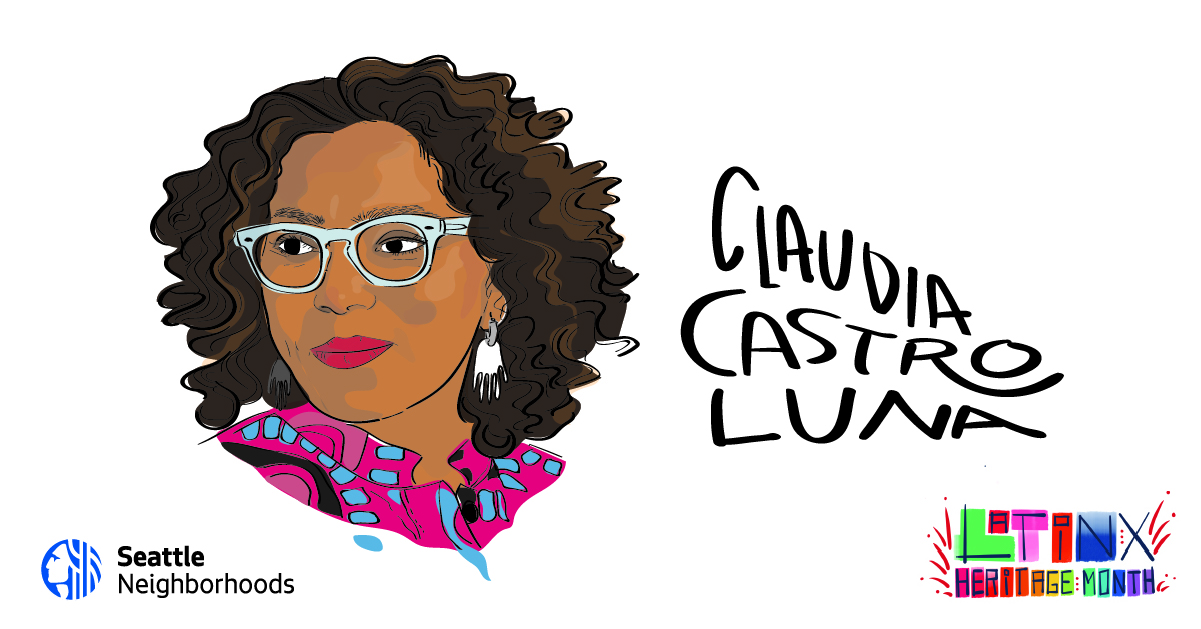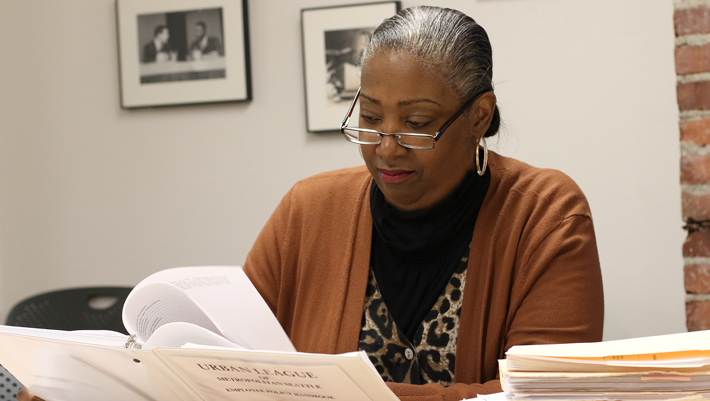
In celebration of Latinx Heritage Month, we have invited founders of Nepantla Cultural Arts Gallery Jake Prendez and Judy Avitia-Gonzalez to curate a series of profiles and stories to amplify and honor people, businesses, organizations, and projects connected to Seattle’s Latinx community.
Azul y Marrón: to be Latinx in Seattle
By Claudia Castro Luna
Azul y Marrón
A group of regal sandhill cranes swoop across the sky above a Duwamish canoe. An East African mother lovingly holds her young daughter with blue planet earth behind them. An emerald quetzal, the official bird of Guatemala, regal in mid-flight. The figure of a woman in a white apron making pupusas. These are some of the elements of a beautiful mural painted on the low wall of a playing field at an Elementary school in West Seattle. Azul y marrón: sky to reach for and earth to ground us.
The mural’s themes are listed as: “culture, migration, family, and history.” Encountering the image of the woman making pupusas caught me off-guard. I stared and stared trying to make sure what I saw was in fact what I saw. Elation, pride, validation, and gratitude rushed in when the side legend confirmed my understanding. Azul y marrón: Yesterday’s ocean, today’s water, and the rich soil of family.
Pupusas—small discs of corn masa stuffed with cheese and edible flowers, meat, or beans—are El Salvador’s national dish. For Salvadorans, pupusas are more than food, they are spiritual sustenance, an umbilical cord to our homeland and to our indigenous ancestors for whom corn was the sun and heart—the kernel of existence. There are thousands of women who, daily, prepare pupusas in El Salvador. Thousands more prepare them all over the U.S. Salvadorans cannot exist without our beloved pupusas. They are core to our identity and a testament to our resilience in the face of the war that forced our exile. This history is what the figure of the woman signals.
Verde la Lima, Amarillo el Limón
It is rare to find the kind of Latinx cultural specificity displayed in the West Seattle mural. The effort was clearly deliberate and executed with local input. To make space for people that feel real and respectful the people represented must have a say. We Latinxs unfurl a long and wide and sonorous flag. When I think of my family back in El Salvador I hear music and see tías y tíos bailando, dancing, into the light. Ay! de las charangas, de las rancheras y del son. Ay! del tango, del mambo, candomblé y del pilón!
Most of the time Latinxs in the U.S. are treated as if we have a collective identity or are glommed under a commercially driven banner day such as Cinco de Mayo. Even for Mexicans, whose history is supposed to be exalted, the fifth of May is a minor blip in the annals of their country’s history. But here in the U.S. the day is glitter and pop and an excuse for commercial exploitation while the rest of us are thrown into the bucket with swirling ice, chilling beers, and ready-mixed margaritas.
Here in the United States, our flag is the flat terrain contained in the six letters in “Latinx.” But our ancestors came from starkly different places, from sun-drenched islands to sparse mountain peaks, to fantastic and fantastically enormous cities. Most of us share the Spanish language, but Brazilians also come from the Southern cone, and each of the Spanish-speaking countries, has its linguistic peculiarities and turns of phrase. We also have indigenous communities who against all odds have conserved their traditions and language. Our diversity is golden. And limas are not limones.
Rojo de Corazón
In the great scope of things, a Latinx being called a Mexican, for instance, when you might not be, is a minor issue. This happens. A lot. I’ve been asked if I speak Mexican. Or asked for recipes for Mexican dishes I, nor anyone in my family, would know how to prepare.
However, the bigger issue is not with our imposed collective identity but our collective invisibility.
At a recent meeting led by folks from the Smithsonian, a group of Seattle residents were asked to mark on a scale from 1 to 10 how often we perceived Latinxs to be represented in our respective neighborhoods. Most (there were Latinxs and non-Latinxs in the room) marked the box with the number one. I marked the number three because of the mural and because I live close to the Salvadoran Bakery. No one in the room was at all surprised at the low scores.
To be Latinx in Seattle is to feel largely invisible. That was the message. And this is not a phenomenon particular to Seattle. Across the state, be it in local government, school boards, cultural institutions, and in public spaces, Latinxs are not represented proportionally to our population numbers. We make up the largest non-white group in the state. We live in cities, rural areas, and the islands in the Salish Sea.
There are moments throughout the year when, like fireworks, Latinxs pop up in the general consciousness. Cinco de Mayo with its flurry of papel picado is an example. Día de los Muertos is another. These moments feel like the revelry of a summer party concluding with a fireworks show: the noise, music, streamers, the lights, the splash of color—then, nothing. Like dew, these instances are ephemeral, their glow goes away soon enough.
Yet, we remain, going about our daily rhythms, tending to our panzas y corazones. We keep going to school, toiling in the fields, punching in at factories, meeting clients as lawyers, doctors, and therapists. We keep making art and nurturing our crafts. We step into the quotidian with sabor and sometimes sinsabor, falling, getting back up, weaving ourselves into the mesh of American life.
Blanco como una pared y como el azúcar
Through our triumphs and struggles, when our work, our artistry, and our histories are left out of the public arena we will remain unseen and treated as irrelevant. The pandemic showed that the work we do as farm workers and laborers is essential to the everyday functioning of our world. So are the artistic and intellectual contributions we make daily.
I do wish there were more moments in public spaces, and in shared discourse, for all the ways we are and for all the ways we contribute to society. I feel invigorated seeing my experience reflected in the narrative of migration and belonging the mural in West Seattle weaves. It can be done. There are a lot of white wall spaces that can sport colorful, important narratives that come from the mouths of young bellies where life’s Sabor y Azúcar reside. This is not by far to say that murals are THE way to honor our contributions. The thought is but one phrase in the songbook we Latinxs make, living and loving, striving and thriving, here in Seattle.
Ritmo Salvi
Español
empanadas de leche para mi papá
frijolitos fritos para mi mamá
paleta de coco para mi tío
cemita de piña para mi tía
y para mi?
pupusas de chicharrón
para alegrar mi corazón!
Salvi Rhythm
English
Milk empanadas for my papá
frijolitos fritos for my mamá
a coconut popsicle for my tío
cemita de piña for my tía
and for me?
pupusas de chicharrón
to cheer up mi corazón!



